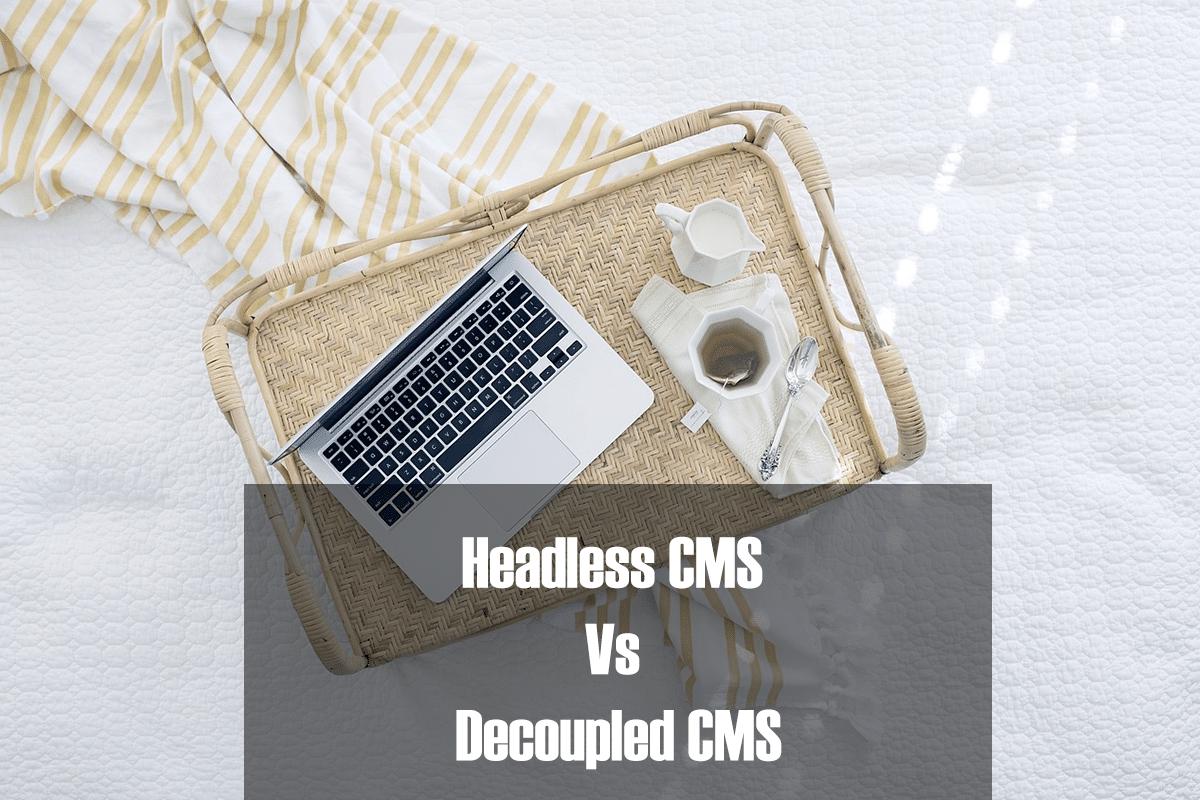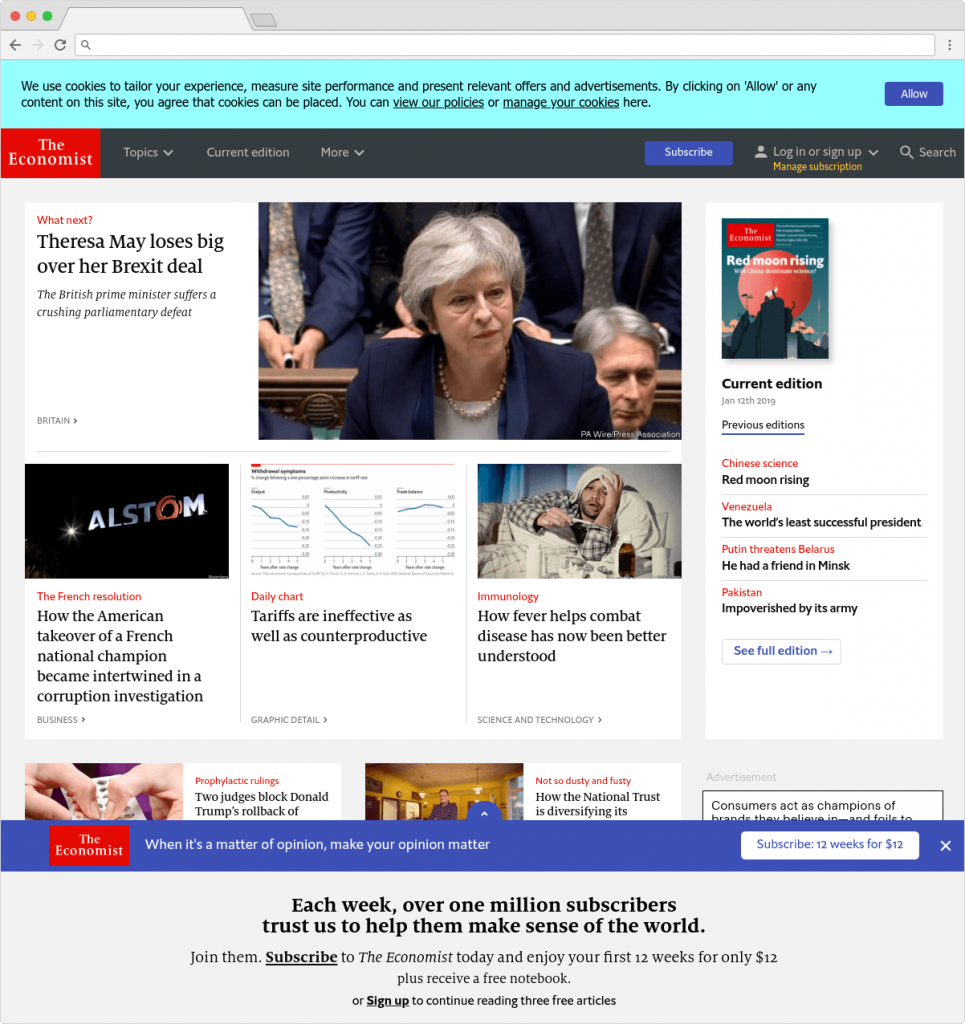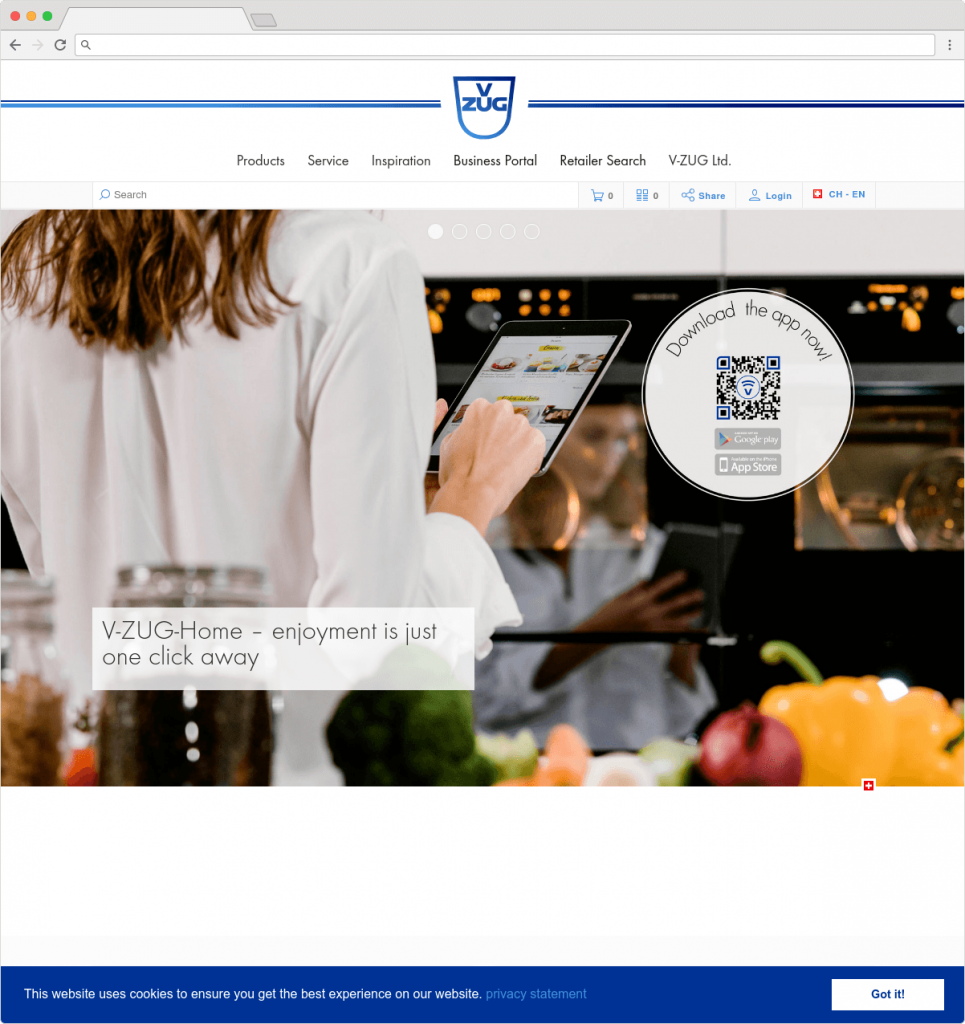Headless CMS Vs Decoupled CMS

The headless CMS space has gained traction in recent years, leading to the renewed excitement around a content management model that can help brands handle the relentless number of emerging devices and channels.
Old debates about the relevance of headless content management have reignited, leading to the invention of new acronyms and spin-off buzzwords that attempt to explain the storm in the CMS-teacup.
What is a traditional Content Management System (CMS)?
Before we define headless content management, let’s first recap on how a ‘traditional’ CMS works.
With a traditional CMS like WordPress, Drupal or Joomla, users create and edit their content through tools like a WYSIWYG editor or an HTML editor and save it to the back-end database. The CMS then displays the content according to the front-end delivery layer built into the CMS.
In WordPress for example, that layer looks like a WordPress template, governed by cascading style sheets (CSS).
A traditional CMS is sometimes referred to as a ‘coupled’ CMS — we’ll discover the reason behind that later.
What is a headless CMS?
If a traditional CMS was a body, the “head” would be the front-end components like the front-end framework and templating system. If you chop that head off, and you’re left with a headless CMS.
A headless platform has no default front-end system to determine how the content is presented to the end user. Instead, it’s front-end agnostic, meaning that your content is raw and can be published anywhere, through any framework.
By getting rid of the front-end delivery layer, your CMS is suddenly a content-only data source. It produces content and then sits there. Waiting.
What’s it waiting for? Well, because there is no default “head”, front-end developers are free to build as many heads as they like, for however many channels they want to serve content to (think websites, apps, kiosks, billboards, smartwatches, etc). To retrieve the content for each channel, the headless CMS responds to API calls.
Okay, so what is a decoupled CMS?
I consider headless content management to be a sub-set of decoupled content management. That’s because a decoupled CMS is headless, and then some.
With a decoupled CMS – also known as a hybrid headless CMS – your content is managed separately and is front-end agnostic, just like a headless CMS. Yet, it has front-end delivery tools in the box, like templates, if you want to use them.
The difference is that the back-end and front-end are not “coupled” to each other through a database like with a traditional CMS. Instead, the front-end and back-end communicate to each other through calls to an API.
So, remember when we chopped the “head” off a traditional CMS to make it headless? Well, imagine the same scenario here, except this time, we kept the head. It’s not attached to the main body as with a traditional CMS — but you aren’t totally left to your own devices when it comes to front-end delivery, like with a headless CMS, either.
It’s the best of both worlds, you might say.
Decoupled CMS vs headless CMS: What’s the difference?
Let’s dig a little deeper into what makes these two models so different.
With a headless CMS, you have modeling and editorial tools to create and edit content. But the concept of “publishing” content just means making it available via an API. It assumes that you and your nerdy front-end development team can handle the rest with whichever frameworks and tools you prefer.
A decoupled CMS, on the other hand, doesn’t assume anything. It does everything a headless CMS does, but it doesn’t stop there. It also says, “Hey, we’ve got some templating tools here so you aren’t working from scratch.”
That’s just good manners, right?B
“A decoupled CMS is proactive — it prepares content for presentation and pushes it into a delivery environment. A headless CMS is reactive — it manages content, then just sits and waits for some process to ask for it.”
For marketers, this subtle difference can be a significant one. While the decoupled CMS uses the templates, WYSIWYG editing, and other tools are customarily seen with traditional CMS systems, many of those tools are not available in a headless CMS architecture. However, purely headless systems allow more control over how the content appears on each type of device. So, more fun for eager front-end developers, less fun for non-tech savvy marketers.
Decoupled vs headless content management: Pros and cons
The headless content management model is growing in popularity — and we’ll explore why that is later. But before that, here are the benefits and drawbacks so you can evaluate the model for yourself.
Headless CMS pros
- Front-end agnostic: A headless or decoupled CMS is front-end framework agnostic. That means you can publish content on any device or channel via API calls. Plus, front-end developers are free to use their favorite frameworks and tools.
- APIs: Application Programming Interfaces (APIs) enable two technologies to speak to each other. Both headless or decouples environments use APIs to connect and communicate with other softwares and channels, allowing for content delivery. But that’s not all. APIs can also be used to send data (like end-user activity and preferences) from those channels, devices, and touchpoints back to the CMS for processing, analysis, and re-distribution.
- Future-proof: APIs aren’t just ready to talk to any existing software or device, they’re prepared to speak to any new device or channel that emerges in 2019 and beyond. Thus, your content will remain future-proof, no matter what innovative device next hits the market.
Headless CMS cons:
- No fun for marketers: Robbed of WYSIWYG editing, blogging functionalities and other user-friendly features, marketers, in particular, are left out in the cold until their development team sees to their needs. This isn’t typically a problem for decoupled CMSs.
- A fragmented tech stack: With a headless CMS, removing the ‘head’ simply means having to hunt for further technologies to replace it. This can entail building front-end solutions in-house, or deploying existing third-party tools to plug the gap. Either way, it could get costly both monetarily and through time spent—not to mention difficult to manage. This problem can be partially alleviated with a decoupled CMS, which will bring those marketer-friendly features right back.
- No content previews: If you do manage to get your marketers back on track be drafting in third-party tools, they still won’t be able to efficiently use a headless CMS, as they won’t be able to easily preview content before it goes live.
Decoupled CMS pros
As we’ve already discussed, a decoupled CMS doesn’t suffer from the same limitationsthat a headless CMS has. Instead, it’s headless, and more, as the list of advantages below demonstrate.
- All the benefits of a headless CMS: As discussed earlier, a decouples CMS is essentially a headless CMS with full-CMS capabilities. Hence, a decoupled CMS gives you the same advantages you’d get with a headless CMS — and then some.
- Optional front-end templates: Unlike a pure headless CMS, a decoupled CMS will likely provide you with templates to help launch websites and pages quickly, and to give your developers a head start on any other front-end presentation layer they wish to build.
- All the tools marketers love: A decoupled CMS doesn’t just give marketers their templates back, it also provides WYSIWYG editing, content previews, and additional content publishing tools.
The need for headlessness
Let’s circle back to the comment I made earlier about the headless CMS space gaining traction. The reason for the surge in the hype surrounding headless content management (and by definition, decoupled content management) is because multi-channel publishing is increasing in complexity.

Again, publishing on multiple channels is nothing new, and most traditional CMSs have allowed for this. Think of a responsive WordPress template, for example. You publish your content once, and the template is flexible enough to showcase it on desktop, tablet, and mobile. Boom, multi-channel baby!
But as we move deeper into the era of IoT, publishing to a handful of channels is no longer cutting the mustard. Large brands want the power to publish their content anywhere — because new channels and devices (such as smartwatches, VR headsets, and smart home assistants) are popping up faster than you can say Content-as-a-Service. Speaking of which…
Choosing a headless CMS: How to wade through the jargon
If you’re shopping around for a headless CMS or decoupled CMS, you’ll notice that the jargon doesn’t end with these two terms. Below, we’ve defined some phrases commonly used by headless CMS vendors.
What is API-first, and what is a headless API?
When a CMS touts itself as being API-first or API-driven, it’s referring to the fact that it uses APIs to deliver content. An API-first CMS is essentially a synonym for a headless or decoupled CMS.
Headless APIs (sometimes called Content API or REST API) are particularly useful for pushing content to a native app, such as an Android or iOS app. It can even be used to deliver content to commerce systems, such as a POS (Point of Sale), and voice-activated applications like Alexa, Cortana, and Siri.
With a Headless API, you can specify content types and fragments that you want to push to the device or touchpoint of your choice.
What does front-end agnostic mean?
The term agnostic in the world of computing refers to a piece of software that is “compatible with many types of platform or operating system”, according to Oxford Dictionaries. Again, we’re dealing with a synonymous term for a headless, decoupled, or API-first CMS. Because APIs are involved, the front-end delivery layer could be anything you desire, from a smartwatch screen to a virtual reality headset, thus making your content front-end agnostic.
With a headless CMS, developers create their own front-end presentation layers in line with the device they’re trying to send content to.
A Decoupled CMS is also front-end agnostic. While they do provide a set of front-end templates and editing tools for building web applications out-of-the-box, you also have the option to create your custom front-end presentation layers to work outside of the framework laid out by the vendor.
What is a hybrid CMS, and what is a hybrid headless CMS?
Once again, while the term Hybrid CMS or hybrid headless CMS may seem like a totally different kettle of digital fish, these two terms are synonymous with the term decoupled CMS.
A hybrid CMS aims to combine the headless content management of a headless CMS, and the editing tool found in a traditional CMS. Thus, a hybrid CMS is just a decoupled CMS with a different name.
What is a content-as-a-service?
Here’s another buzzword playing a role in the headless CMS realm.
Various headless CMS vendors are claiming that their model of content management can be described as ‘Content-as-a-Service’ (CaaS), a sub-set of ‘Software-as-a-Service’ (SaaS).
Software-as-a-Service isn’t about the technical inner-workings of a CMS. Instead, it’s the model used by vendors — and favored by brands — to sell their software.
Instead of building their own technology, or buying licensing fees from software vendors, many brands are turning towards cloud-based software that they can pay a monthly subscription for. The software is managed and hosted by the vendor, leaving the brand to “borrow” the technology to build and scale their digital presence. Hence, it’s a software, but in the form of a service.
As headless content management gained traction, so did the term Content-as-a-Service, because, you know, a headless CMS is all about the content, and nothing but the content.
It’s worth noting that the demand for SaaS products is growing exponentially, with IDC forecasting that by 2020, penetration of software as a service versus traditional software deployment will be over 25%.
So, if decoupled CMS gives you the best of both worlds (headlessness plus front-end goodies) when it comes to content management, and a cloud-based SaaS (or CaaS, if you want to be super specific) model is the best way to “borrow” that technology. I guess the ideal solution would be a Decoupled SaaS CMS.
Does a headless CMS help with omnichannel marketing?
Both headless and decoupled CMS give marketers the ability to deliver omnichannel customer experiences.
Omnichannel marketing enables brands to deliver a seamless, integrated and continuous experience across all touchpoints and devices, preventing a disjointed customer journey if and when the customer switches from one device to another. Omnichannel marketing is different to multi-channel marketing, since the latter operates through each channel separately, and without connecting the experiences together.
Headless content management can help brands launch and manage omnichannel marketing campaigns. Below, we’ve discussed how.
1. Faster to market
Consumers have now become used to getting what they want at speed—and that includes new experiences on new devices.
With a traditional CMS, brands need to draft in developers to build custom integrations and platforms to present content on the new channel. With a headless CMS, developers can simply deliver content via API calls to the device or touchpoint in question, allowing them to focus solely on the UI and the end-user experience. Naturally, this greatly decreases the time to market when a brand wants to adopt a new touchpoint into its omnichannel experience.
2. A flexible technology stack
Traditional CMSs usually attempt to be a jack of all trades, leaving companies bound to the tools and integrations made available to them by the vendor. This leads to a rigid technology stack that’s difficult to adapt or expand. The end result leads to the company having great technology in some areas of their business, but having no choice but to stick with poor technology in other parts of their business—for example, with their CRM system or support ticketing system.
But with a headless CMS, APIs are used to integrate with any third-party tool, allowing marketers and developers to switch between tools and adopt new technologies—thus ensuring that they’re always using cutting-edge technology in all areas of the business.
For example, you can have one tool that provides marketing automation, another tool that will help you deliver experiences to smartwatches and a subsequent tool for taking payments from voice-activated applications. All of these tools can be integrated and accessed via the headless CMS.
Plus, if you begin to face problems with a tool, you can simply swap it out for a different one, putting the issue of vendor lock-in to bed.
3. Deliver more personalized experiences
A report by Business2Community shows that 56 percent of consumers are more likely to buy from a retailer that offers personalization. The same report also shared that a staggering 74 percent get frustrated when they see content that does not match their interests.
While a headless CMS doesn’t necessarily promote personalization in and of itself, it does open the door to headless commerce, enabling brands to deliver personalized shopping experiences to IoT devices and smart displays. Plus, thanks again to the APIs at play, the headless CMS can collect data which can, in turn, be used to fuel a personalization campaign across channels. perspective, your omnichannel strategy needs to be put personalized content right at the heart of the customer experience.
Some headless CMS providers, like Core dna, come with engagement tracking and analytics that can monitor a customer’s journey through different touchpoints. With this information, you can deliver personalized content at different stages in the customer journey, thereby improving the likelihood of conversion.
Headless CMS examples: 3 companies using a headless or decoupled CMS
Countless brands are using headless architectures to distribute content to new channels, integrate third-party tools, and collect data at scale. Here are three examples.
1. Princess Cruises

Providing personalized omnichannel experiences across multiple cruise ships is no mean feat, but with a decoupled CMS, Princess Cruises manages just fine.
The cruise ship operator uses a decoupled CMS as a central content hub to distribute personalized, real-time, and multilingual content and customer experiences across mobile apps and onboard passenger-facing screens.
Passengers can use smartphones or tablets to access Princess Cruise’s native mobile app, where they can access deck plans, browse activities, and keep a personalized plan of their time onboard.
2. The Economist

The Economist is a prime example of a brand looking to penetrate almost every mainstream channel and touchpoint on the market—a feat that’s only feasible with a headless or decoupled CMS.
The global news and op-ed publisher uses a headless CMS to push content to channels including native mobile apps, Snapchat, The Economist Alexa Skill, Oculus, and much more. In other words, the brand is now accessible through mobile, social media, voice, and virtual reality devices, with one headless CMS serving the content.
3. V-Zug

V-Zug is a Swiss luxury appliance maker that needed an eCommerce solution with headless commerce capabilities in order to integrate their eCommerce ecosystem with various back-end systems.
V-Zug used Core dna, a decoupled eCommerce and DXP solution, to achieve their aim. They leveraged Core dna’s 80+ pre-built applications to handle payments, overstock management, and dynamic pricing. Further, the end product used Core dna’s APIs to seamlessly integrate with several back-end systems, including V-ZUG’s SAP ERP, providing customers with a seamless experience and real-time access to product information, accurate pricing, and product availability and shipping data.
The future is here, and it’s headless
The future of CMS is quickly moving away from traditional, database-driven systems and toward API-driven headless or decoupled systems.
Consumers are making use of more devices and channels than ever before, and brands simply have to meet them there in order to provide quality omnichannel customer experiences. Going headless, whether that’s through a pure headless CMS or a decoupled CMS, is the simplest way to achieve that.